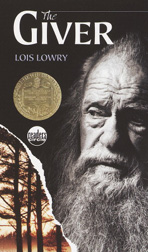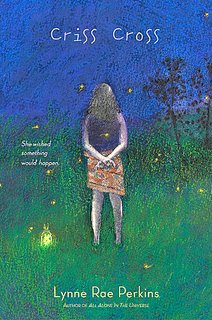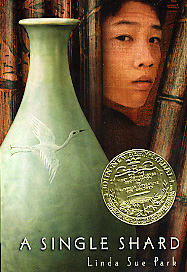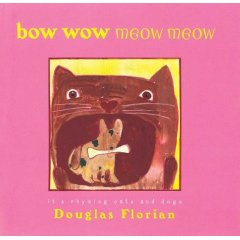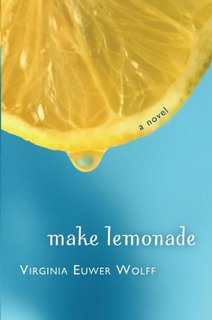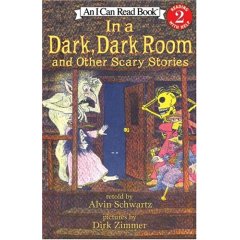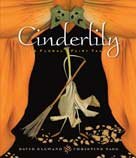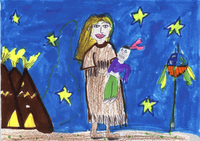
Book Review: A STEP FROM HEAVEN
*NOTE: This review was created for a class at TWU.
1. BIBLIOGRAPHY:
Na, An. 2001. A STEP FROM HEAVEN. Asheville, NC: Front Street. ISBN 1886910588
2. PLOT SUMMARY: In An Na's bittersweet realistic novel, A STEP FROM HEAVEN, Young Ju, a Korean girl, grows up, learns to make her way in America, and struggles to deal with her father's alcoholism and abuse.
3. CRITICAL ANALYSIS:
Often, a writer's first novel contains a very strong voice, but lacks craft, or vice versa. The 2002 ALA Printz Award-winning novel A STEP FROM HEAVEN is an exception, combining a clear voice with a well-crafted plot and structure. An Na's novel spans a girl's life from toddler to university student, and while the novel incorporates themes prevalent in realistic young adult fiction such as independence, generational conflict, powerlessness and dominance, rebellion and self-awareness, it also reflects the protagonist's journey into adulthood with a unique structure.
First, A STEP FROM HEAVEN addresses Young Ju's forays into independence, from the first resistance as a five year old to being pretty because it means "you cannot play in your nice clothes," to the young woman who is able to make straight A's in school, clean house, buy groceries, and cook while her mother works 3 jobs to keep the family together. Young Ju keeps the meaningful ways of her Korean past, but also forges her own path in America, becoming her mother's "strong girl."
The ways of the past, including traditional values such as being an obedient daughter and being subservient to the males in the family, creates a generational conflict between Young Ju and her parents, in particular, her father. As Young Ju matriculates through the American school system, she assimilates in to American culture, and cannot help but compare her family dynamics with those of her friend Amanda. In the chapter entitled "Daughter," Young Ju gets a ride home from an award ceremony at school where she was named 1st in her class. In the car, she smiles as Amanda's father begins to sing along to the radio, and winks at the girls in the rear view mirror. It is a stark contrast to what Young Ju finds at home. While her mother is very pleased with the girl's award, her father makes no mention of it and appears not to even have looked at it until Young Ju notices it has a smudge on it and smells like him, indicating he did see it. Her inability to have a close and loving relationship with her father tears at her, and she thinks, "An ache deep and wide as the sea threatens to drown my heart."
Yet, the conflict in Young Ju's family stems from more than the strictness of a tradition Korean family hierarchy. Young Ju's father, or Apa, is both alcoholic and abusive. Her mother, or Uhmma, is powerless to leave him, and any of her own small acts of rebellion such as demanding to know where he's been are rewarded with slaps and punches. Once Young Ju and her brother Joon are older, they both become victims of abuse, learning to "look blank as if you are listening when really you are trying to fly away from your body" in the face of the verbal abuse that always precedes the beatings. When Uhmma is nearly killed trying to protect Young Ju, the girl finally tips the scales on her father's dominance by calling 911. Although Uhmma refuses to press charges, this act ends the family's powerlessness, and eventually Apa returns to Korea without them.
In addition, A STEP FROM HEAVEN is a deeply personal account of a girl's developing self-awareness. And it is this theme which is most reflected in the novel's structure. Without being contrived, An Na succeeds in creating a narrative voice which ages as Young Ju ages. The first chapters are very short, with simple thoughts and sentences. "Cold. Cold water. Oh. My Toes are fish. Come here. Fast. Look." thinks the toddler Young Ju. Later, on her first day of school in America, five-year-old, Young Ju muses, "I think future must mean a long time away. Except school is not in the future. It is now. I do not understand how school is my future when it is not a long time away." Compare this to the self-assured narration of Young Ju as a high school senior, "The patch of grass is so small you can walk across in four long strides. But I don't care. It is ours. I walk barefoot back and forth across the vibrant green lawn, take in deep breaths of air. My toes clutch the tiny blades, revel in the softness and the damp earth beneath my feet. All ours."
Interwoven within the change in narrative style is not only Young Ju's growth as a young woman, but also her acclimation to America and the English language. Whereas the early chapters are filled with words and phrases she doesn't know yet such as when the teacher says "All right, class, come over here," and Young Ju hears "Ah ri cas, ca mo ve he," the quote above shows a woman whose vocabulary includes words such as "strides," "vibrant," and "clutch." The vivid words of a college bound graduate.
Finally, A STEP FROM HEAVEN, which deals with such difficult issues as abuse and acoholism, is an honest look at the complexity of family dynamics and life. A close look at the structure of the novel reveals that the chapters loosely alternate between good and bad memories, beginning and ending with a good memory. In the beginning, we have the happy memory of a toddler getting her first feeling of being in the ocean, under the safe and comforting watch of a loving relative, whom I assumed to be her grandmother. In the end, sifting through photographs, Young Ju sees one of her with her father, and that memory resurfaces, revealing that her father wasn't always an abusive, distant alcoholic. After living through Young Ju's terrible suffering, the reader glimpses Apa as a dreamer, with a "broad grin" and eyes which crinkle "like the eyes of sleepy cats in the sun," reminding us that people change, and perhaps forgiveness can heal.
An Na's bittersweet optimism, honesty, and shunning of didacticism, along with her evolving narrative style, bring A STEP FROM HEAVEN to a level above many young adult accounts of growing up. Readers will be able to connect with the struggles of Young Ju, and will rejoice in her independence, while gaining an understanding of the immigrant experience.
4. REVIEW EXCERPT(S)
BOOKLIST: (Starred Review) "This isn't a quick read, especially at the beginning when the child is trying to decipher American words and customs, but the coming-of-age drama will grab teens and make them think of their own conflicts between home and outside. As in the best writing, the particulars make the story universal."
PUBLISHERS WEEKLY: "In fluid, lyrical language, Na convincingly conveys the growing maturity of her perceptive narrator who initially (and seamlessly) laces her tale with Korean words, their meaning evident from the context. And by its conclusion, readers can see a strong, admirable young woman with a future full of hope. Equally bright are the prospects of this author; readers will eagerly await her next step."
5. CONNECTIONS & STRATEGIES
* At the high school level, this book would be a good choice for a thematic unit on the immigrant experience in America. Pair A STEP FROM HEAVEN with other titles such as Sandra Cisneros's A HOUSE ON MANGO STREET (ISBN 0679734775) and REMIX: CONVERSATIONS WITH IMMIGRANT TEENAGERS (ISBN 0805051139) by Maria Tamar Budhos,to help students identify issues immigrant teens have at home, in school, and with the older generation. The teacher may want to find people in the community who would be willing to talk about their own immigrant experience and allow the students to conduct their own interviews in person or via email. For an insightful interview with An Na in which she discusses the influence of Sandra Cisneros's novel on her work, go to : http://www.cynthialeitichsmith.com/lit_resources/authors/interviews/AnNa.html
* Since A STEP FROM HEAVEN ends with a new beginning and revelations about Young Ju’s father, it would a good candidate for an activity called “The Rest of the Story.” Students create a summary of the story and then tell “the rest of the story” a la Paul Harvey using the subtext or a follow-up that wasn’t explicitly told. They might explore what happens later, whose story wasn’t told and now will be told, or what new twist or information might be added. For this lesson and other ideas on how to deepen students’ comprehension of texts, see Jeffrey Wilhelm’s ACTION STRATEGIES FOR DEEPENING COMPREHENSION (ISBN 0439218578)
